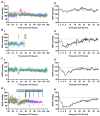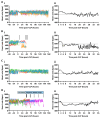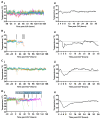Precision Profiling of Disease Progression in Murine Models of Sepsis and Septic Shock
- PMID: 41155249
- PMCID: PMC12562319
- DOI: 10.3390/ijms26209954
Precision Profiling of Disease Progression in Murine Models of Sepsis and Septic Shock
Abstract
Septic shock has an unacceptably high mortality rate and unmet need for new therapeutics. Murine models are crucial for research, yet methodologies often differ. This study characterised standard- and high-grade caecal ligation and puncture (CLP) murine models of septic shock by integrating ultraminiature arterial telemetry with comprehensive plasma biomarker analysis. Standard-grade and high-grade CLP was performed in 8-10 week old, male C57BL/6 mice (n = 98), with a subset implanted with arterial telemetry to monitor real-time circulatory function. Plasma markers of inflammation and organ damage were measured at multiple intervals up to 168 h post-CLP. Standard-grade and high-grade CLP showed distinct progressions; episodes of hypotension began 5-6 h after CLP in 30% of standard-grade and all high-grade CLP mice, with respective 168 h mortality of 40% and 71%. Recurrent episodes of hypotension 5-39 h after CLP were universally lethal. The coincidence of hypotension and elevated plasma lactate defined the onset of septic shock after high-grade CLP, which was always lethal. Inflammatory cytokines and markers of liver, renal, and cardiac damage were markedly elevated to 168 h after high-grade CLP, in contrast to standard-grade CLP, which returned to baseline by 48 h. Elevated plasma IL-6, TNFα, and corticosterone, along with reduced albumin, were significantly correlated with mortality. In conclusion, this research refines murine CLP models by providing a precise, dynamic map of the progression to septic shock. The high-grade CLP model consistently models early and late-stage physiological deterioration and serves as a robust model for evaluating the efficacy of novel therapies aimed at human septic shock.
Keywords: sepsis; septic shock; telemetry.
Conflict of interest statement
The authors declare no conflicts of interest.
Figures









References
-
- Singer M., Deutschman C.S., Seymour C.W., Shankar-Hari M., Annane D., Bauer M., Bellomo R., Bernard G.R., Chiche J.-D., Coopersmith C.M., et al. The Third International Consensus Definitions for Sepsis and Septic Shock (Sepsis-3) JAMA. 2016;315:801–810. doi: 10.1001/jama.2016.0287. - DOI - PMC - PubMed
MeSH terms
Substances
Grants and funding
LinkOut - more resources
Full Text Sources
Medical
Miscellaneous

